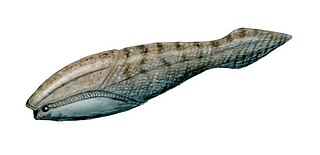
Arandaspida is a taxon of very early, jawless prehistoric fish which lived during the Ordovician period. Arandaspids represent the oldest known craniates, a proposed group of chordates that contain all chordates with a cartilage-derived skull, and hagfish. The group represents a subclass within the class Pteraspidomorphi, and contains only one order, the Arandaspidiformes. The oldest known genus of this group is Sacabambaspis found in South America.

Bothriolepis was a widespread, abundant and diverse genus of antiarch placoderms that lived during the Middle to Late Devonian period of the Paleozoic Era. Historically, Bothriolepis resided in an array of paleo-environments spread across every paleocontinent, including near shore marine and freshwater settings. Most species of Bothriolepis were characterized as relatively small, benthic, freshwater detritivores, averaging around 30 centimetres (12 in) in length. However, the largest species, B. rex, had an estimated bodylength of 170 centimetres (67 in). Although expansive with over 60 species found worldwide, comparatively Bothriolepis is not unusually more diverse than most modern bottom dwelling species around today.
This glossary of ichthyology is a list of definitions of terms and concepts used in ichthyology, the study of fishes.
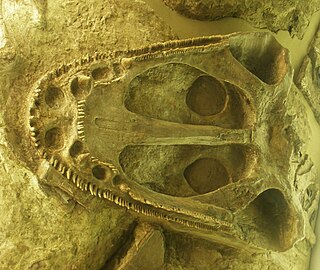
Mastodonsauridae is a family of capitosauroid temnospondyls. Fossils belonging to this family have been found in North America, Greenland, Europe, Asia, and Australia. The family Capitosauridae is synonymous with Mastodonsauridae.

Stanocephalosaurus is an extinct genus of large-sized temnospondyl amphibians living through the early to mid Triassic. The etymology of its name most likely came from its long narrow skull when compared to other temnospondyls. Stanocephalosaurus lived an aquatic lifestyle, with some species even living in salt lakes. There are currently three recognized species and another that needs further material to establish its legitimacy. The three known species are Stanocephalosaurus pronus from the Middle Triassic in Tanzania, Stanocephalosaurus amenasensis from the Lower Triassic in Algeria, and Stanocephalosaurus birdi, from the middle Triassic in Arizona. Stanocephalosaurus rajareddyi from the Middle Triassic in central India needs further evidence in order to establish its relationship among other Stanocephalosaurs. Like other temnospondyls, Stanocephalosaurus was an aquatic carnivore. Evidence of multiple species discovered in a wide range of localities proves that Stanocephalosaurus were present all across Pangea throughout the early to mid Triassic.

Pteraspidiformes is an extinct order of heterostracan agnathan vertebrates known from extensive fossil remains primarily from Early Devonian strata of Europe and North America, and from Upper Silurian Canada.
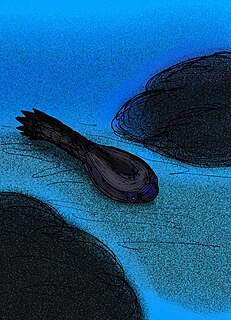
Cyathaspidiformes is an extinct order of heterostracan vertebrates known from extensive fossil remains primarily from Silurian to Early Devonian strata of Europe, and North America, and from Early Devonian marine strata of Siberia.

Amphiaspidida is a taxon of extinct cyathaspidid heterostracan agnathans whose fossils are restricted to Lower Devonian marine strata of Siberia near the Taimyr Peninsula. Some authorities treat it as a suborder of Cyathaspidiformes, while others treat it as an order in its own right as "Amphiaspidiformes." In life, they are thought to be benthic animals that lived most of their lives mostly buried in the sediment of a series of hypersaline lagoons. Amphiaspids are easily distinguished from other heterostracans in that all of the plates of the cephalothorax armor are fused into a single, muff-like unit, so that the forebody of the living animal would have looked like a potpie or a hot waterbottle with a pair of small, or degenerated eyes sometimes flanked by preorbital openings, a pair of branchial openings for exhaling, and a simple, slit-like, or tube-like mouth.

Amphiaspidoidei is a taxon of extinct amphiaspidid heterostracan agnathans whose fossils are restricted to Lower Devonian marine strata of Siberia near the Taimyr Peninsula. In life, the amphiaspidids of Amphiaspidoidei are thought to be benthic animals that lived most of their lives mostly buried in the sediment of a series of hypersaline lagoons. Amphiaspids are easily distinguished from other heterostracans in that all of the plates of the cephalothorax armor are fused into a single, muff-like unit, so that the forebody of the living animal would have looked like a potpie or a hot waterbottle with a pair of small, or degenerated eyes flanked by preorbital openings, a pair of branchial openings for exhaling, and a simple, slit-like mouth.
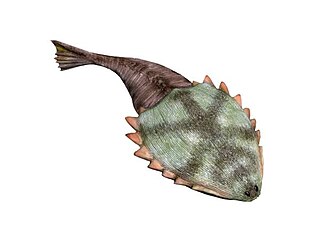
Hibernaspidoidei is a taxon of extinct amphiaspidid heterostracan agnathans whose fossils are restricted to Lower Devonian marine strata of Siberia near the Taimyr Peninsula. In life, hibernaspid amphiaspidids are thought to be benthic animals that lived most of their lives mostly buried in the sediment of a series of hypersaline lagoons. All amphiaspids are easily distinguished from other heterostracans in that all of the plates of the cephalothorax armor are fused into a single, muff-like unit, so that the forebody of the living animal would have looked like a potpie or a hot waterbottle with a pair of small, or degenerated eyes, a pair of branchial openings for exhaling, and, in the case of hibernaspids, a simple, slit-like mouth at the anterior end of a tube-like head.
Siberiaspidoidei is a taxon of extinct amphiaspidid heterostracan agnathans whose fossils are restricted to Lower Devonian marine strata of Siberia near the Taimyr Peninsula. In life, siberiaspids are thought to be benthic animals that lived most of their lives mostly buried in the sediment of a series of hypersaline lagoons. As with all amphiaspids, siberiaspids are easily distinguished from other heterostracans in that all of the plates of the cephalothorax armor are fused into a single, muff-like unit, so that the forebody of the living animal would have looked like a flattened potpie or a hot waterbottle with a pair of small, or degenerated eyes sometimes flanked by preorbital openings, a pair of branchial openings for exhaling, and a simple, slit-like, or tube-like mouth.

Amphiaspididae is a family of extinct amphiaspidid heterostracan agnathans whose fossils are restricted to Lower Devonian marine strata of Siberia near the Taimyr Peninsula. In life, the amphiaspidids of Amphiaspididae are thought to be benthic animals that lived most of their lives mostly buried in the sediment of a series of hypersaline lagoons. Amphiaspids are easily distinguished from other heterostracans in that all of the plates of the cephalothorax armor are fused into a single, muff-like unit, so that the forebody of the living animal would have looked like a potpie with a pair of small, or degenerated eyes, with each flanked by a preorbital opening, and a simple, slit-like mouth.

Amphiaspis argo is the type species of the cyathaspidid taxon Amphiaspidida, and of the family Amphiaspididae. Its fossils are restricted to early Emsian-aged marine strata of the Taimyr Peninsula, Early Devonian Siberia. A. argo, as with all other amphiaspidids, is thought to have been a benthic filter feeder that lived on top of, or buried just below the surface of the substrate of hypersaline lagoon-bottoms.

Amphoraspis stellata is an amphiaspidid heterostracan in the family Amphiaspididae. Its fossils are restricted to early Devonian-aged marine strata of the Taimyr Peninsula, Siberia. A. stellata, as with all other amphiaspidids, is thought to have been a benthic filter feeder that lived on top of, or buried just below the surface of the substrate of hypersaline lagoon-bottoms.
Edaphaspis bystrowi is an extinct amphiaspidid cyathaspidid heterostracan. Its fossils are restricted to early Devonian-aged marine strata of the Taimyr Peninsula, Early Devonian Siberia. E. bystrowi, as with all other amphiaspidids, is thought to have been a benthic filter feeder that lived on top of, or buried just below the surface of the substrate of hypersaline lagoon-bottoms. It is the only representative of the family Edaphaspididae.
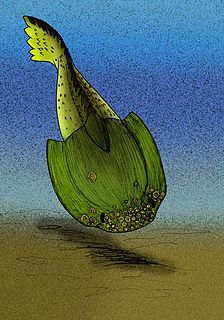
Gabreyaspididae is a family of extinct amphiaspidid heterostracan agnathans whose fossils are restricted to Lower Devonian marine strata of Siberia near the Taimyr Peninsula. In life, all amphiaspidids are thought to be benthic animals that lived most of their lives mostly buried in the sediment of a series of hypersaline lagoons. Amphiaspids are easily distinguished from other heterostracans in that all of the plates of the cephalothoracic armor are fused into a single, muff-like unit, so that the forebody of the living animal would have looked, in the case of gabreyaspidids, vaguely like a horseshoe crab with a pair of small, or degenerated eyes, with each flanked by a preorbital opening, and a simple, slit-like mouth positioned slightly ventrally.
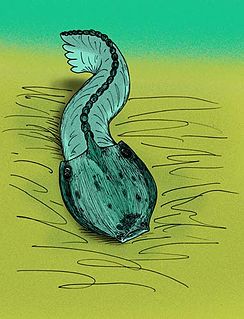
Olbiaspididae is a family of extinct amphiaspidid heterostracan agnathans whose fossils are restricted to Lower Devonian marine strata of Siberia near the Taimyr Peninsula. In life, all amphiaspidids are thought to be benthic animals that lived most of their lives mostly buried in the sediment of a series of hypersaline lagoons. Amphiaspids are easily distinguished from other heterostracans in that all of the plates of the cephalothoracic armor are fused into a single, muff-like unit, so that the forebody of the living animal would have looked, in the case of olbiaspidids, vaguely like a hot water bottle with a pair of small, or degenerated eyes, with each flanked by a preorbital opening, and a simple, slit-like mouth positioned at the anteriormost portion of the cephalothoracic armor.

Hibernaspis is a genus of extinct amphiaspidid heterostracan agnathans whose fossils are restricted to Lower Devonian marine strata of Siberia near the Taimyr Peninsula. In life, species of Hibernaspis were thought to be benthic animals that lived most of their lives mostly buried in the sediment of a series of hypersaline lagoons. All amphiaspids are easily distinguished from other heterostracans in that all of the plates of the cephalothorax armor are fused into a single, muff-like unit, so that, in the case of Hibernaspis, the forebody of the living animal would have looked like a large guitar pic with serrated edges, with a pair of tiny, degenerated eyes, a pair of branchial openings for exhaling, and a simple, slit-like mouth at the anterior end.

Kalthifrons is an extinct monospecific genus of mekosuchine crocodylian known from the Pliocene Tirari Formation in Australia. It contains a single species, Kalthifrons aurivellensis.
Eardasaurus is a genus of thalassophonean pliosaurid from the middle Jurassic Oxford Clay Formation. The animal would have measured over 4.7 m (15 ft) long and possessed a high amount of teeth relative to other pliosaurs. Its teeth show distinct ridges formed by the tooth enamel, some of which are very pronounced and similar to carinae, giving the teeth a cutting edge.












